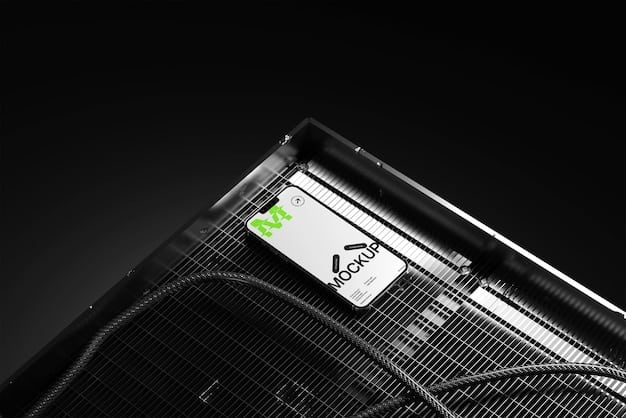The Future of Console Hardware: Next-Gen Gaming Expectations

The future of console hardware points towards significant advancements in processing power, graphics capabilities, storage solutions, and immersive technologies, promising a new era of gaming experiences.
The gaming world is always on the cusp of innovation, and the future of console hardware is no exception. Get ready to explore what the next generation of gaming consoles might bring.
The Evolution of Console Gaming
Console gaming has come a long way since its humble beginnings. From pixelated graphics to photorealistic environments, the evolution has been relentless, driven by technological advancements and a desire for more immersive experiences.
Understanding the history of console development provides valuable context for predicting future trends. Each generation has brought significant leaps in processing power, graphics capabilities, and storage solutions.
Early Days of Console Gaming
The first generation of consoles, like the Atari and Magnavox Odyssey, introduced gaming to the masses. These systems had limited capabilities but paved the way for future innovations.
The 8-bit and 16-bit Eras
Consoles like the Nintendo Entertainment System (NES) and Sega Genesis brought significant improvements in graphics and gameplay, introducing iconic characters and franchises that are still popular today.
- The shift from 8-bit to 16-bit brought richer colors and more detailed sprites.
- Sound capabilities improved, with more complex soundtracks and sound effects.
- Gameplay became more sophisticated, with longer and more engaging stories.
The evolution continued with the introduction of 3D graphics, online multiplayer, and cloud gaming. These milestones show a clear trajectory towards more powerful, connected, and immersive gaming experiences.

In conclusion, the evolution of console gaming demonstrates a consistent drive towards greater realism, more complex gameplay, and enhanced connectivity. This historical context is essential for understanding the potential future of console hardware.
Processing Power and Graphics Capabilities
One of the most significant aspects of the future of console hardware is the expected increase in processing power and graphics capabilities. These advancements will enable developers to create more detailed, realistic, and immersive game worlds.
The current generation of consoles, like the PlayStation 5 and Xbox Series X, already offer impressive performance. However, there is still room for improvement, especially in areas like ray tracing and AI processing.
Advancements in CPU and GPU Technology
The next generation is likely to feature even more powerful CPUs and GPUs, possibly based on new architectures and manufacturing processes. This will allow for higher frame rates, better resolutions, and more complex visual effects.
The Role of Ray Tracing
Ray tracing is a rendering technique that simulates the way light interacts with objects, creating more realistic reflections, shadows, and lighting effects. As hardware becomes more powerful, ray tracing will become more prevalent in console games.
- Improved realism in lighting and reflections.
- More immersive and visually stunning environments.
- Enhanced visual fidelity for a more cinematic gaming experience.
Advancements in artificial intelligence (AI) processing will also play a crucial role. AI can be used to create more intelligent enemies, more realistic character animations, and more dynamic game worlds.
The improvements in these areas will lead to games that are not only visually stunning but also more engaging and responsive to player actions.
Storage Solutions and Memory
Storage solutions and memory are critical components of console hardware. Faster storage and more memory can significantly improve loading times, reduce stuttering, and enable larger, more complex game worlds.
The current generation of consoles has already made significant strides in this area with the introduction of solid-state drives (SSDs). However, the future holds even more promise.
The Transition to SSDs
SSDs offer much faster read and write speeds compared to traditional hard drives. This results in significantly reduced loading times and improved overall system performance.
Potential for NVMe and Beyond
NVMe (Non-Volatile Memory Express) is a storage interface that offers even faster speeds than traditional SSDs. The next generation of consoles could adopt NVMe or other advanced storage solutions.
- Even faster loading times, potentially eliminating loading screens altogether.
- Improved streaming of game assets, allowing for larger and more detailed game worlds.
- Enhanced system responsiveness and overall smoothness of gameplay.
Increased memory capacity will also be important. More memory allows consoles to handle more complex game assets and run more applications simultaneously.

In summary, advancements in storage solutions and memory will be crucial for enabling the next generation of console gaming experiences. Faster loading times, larger worlds, and improved system performance will all contribute to a more immersive and enjoyable gaming experience.
Immersive Technologies: VR, AR, and Beyond
Immersive technologies like virtual reality (VR) and augmented reality (AR) have the potential to revolutionize console gaming. These technologies can create more engaging and interactive experiences, blurring the lines between the real world and the virtual world.
While VR has been around for several years, it has yet to fully take off in the console gaming space. However, advancements in technology and decreasing costs could make VR more accessible in the future.
The Promise of VR Gaming
VR offers a completely immersive gaming experience, allowing players to step into the game world and interact with it in a natural and intuitive way.
Augmented Reality Integration
AR overlays digital information onto the real world, creating new and exciting possibilities for gaming. AR games could be played in the real world, with virtual characters and objects interacting with the player’s environment.
- Enhanced realism and a greater sense of presence.
- New forms of gameplay and interaction.
- The potential for social VR experiences, allowing players to connect and interact in virtual worlds.
Beyond VR and AR, other immersive technologies could also play a role in the future of console gaming. Haptic feedback, eye tracking, and brain-computer interfaces are all technologies that could enhance the gaming experience.
The integration of immersive technologies into console gaming could lead to a new era of gaming experiences that are more engaging, interactive, and personalized.
Cloud Gaming and Streaming Services
Cloud gaming and streaming services are becoming increasingly popular, offering players the ability to play games on a variety of devices without the need for expensive hardware. These services could play a significant role in the future of console gaming.
Services like Xbox Cloud Gaming and PlayStation Plus already allow players to stream games to their consoles, PCs, and mobile devices. As internet infrastructure improves, these services are likely to become even more prevalent.
Accessibility and Convenience
Cloud gaming offers accessibility and convenience, allowing players to play games on a variety of devices without the need for expensive hardware or downloads.
Potential for Enhanced Social Gaming
Cloud gaming could also enable new forms of social gaming, allowing players to easily connect and play with friends regardless of their location or hardware.
- Reduced hardware costs and increased accessibility.
- The ability to play games on a variety of devices.
- New forms of social gaming and interaction.
However, cloud gaming also faces challenges, such as latency and internet bandwidth requirements. These challenges will need to be addressed in order for cloud gaming to become a mainstream option.
The future of console gaming may involve a hybrid approach, with some games being played locally on console hardware and others being streamed from the cloud. This would allow players to choose the best option based on their needs and preferences.
Ecosystem and Services Integration
The future of console hardware is not just about the hardware itself, but also about the ecosystem and services that surround it. Console manufacturers are increasingly focused on building comprehensive ecosystems that include online services, digital stores, and subscription programs.
Services like Xbox Game Pass and PlayStation Plus offer players access to a library of games for a monthly fee. These services are becoming increasingly popular and could play a significant role in the future of console gaming.
The Rise of Subscription Services
Subscription services offer a cost-effective way for players to access a wide range of games. They also provide a recurring revenue stream for console manufacturers and game developers.
Cross-Platform Play and Progression
Cross-platform play allows players to play games with friends regardless of the platform they are using. Cross-platform progression allows players to carry their progress and achievements across different platforms.
- Increased value and convenience for players.
- Recurring revenue streams for console manufacturers and game developers.
- Enhanced social gaming experiences through cross-platform play.
The integration of these services into the console ecosystem creates a more engaging and rewarding experience for players. It also strengthens the bond between players and the console brand.
In the future, we can expect to see even more integration between console hardware, online services, and subscription programs. This will create a more seamless and connected gaming experience.
| Key Point | Brief Description |
|---|---|
| 🚀 Increased Power | CPUs and GPUs offer higher frame rates and resolutions. |
| 💾 Faster Storage | SSDs and NVMe reduce loading times significantly. |
| 🌐 Cloud Gaming | Play games on various devices without expensive hardware. |
| 🎮 Immersive Tech | VR/AR integration enhances gaming experiences. |
FAQ
▼
Future consoles are likely to feature more powerful CPUs and GPUs, based on new architectures. This will enable higher frame rates, better resolutions, and more complex visual effects in games.
▼
The transition to SSDs is already underway, and future consoles may adopt NVMe or other advanced storage solutions. This will result in faster loading times and improved system performance.
▼
Cloud gaming offers accessibility and convenience, allowing players to stream games to various devices without expensive hardware. It may become a mainstream option with improved internet infrastructure.
▼
VR offers immersive experiences, while AR could overlay digital information onto the real world. These technologies promise new forms of gameplay and interaction, enhancing realism and engagement.
▼
Console manufacturers are focused on building comprehensive ecosystems with online services and subscription programs. This includes cross-platform play, creating a more engaging and rewarding player experience.
Conclusion
The future of console hardware is an exciting prospect, with advancements in processing power, storage solutions, and immersive technologies promising a new era of gaming experiences. From enhanced realism to increased accessibility, the next generation of consoles is poised to redefine the way we play games.





